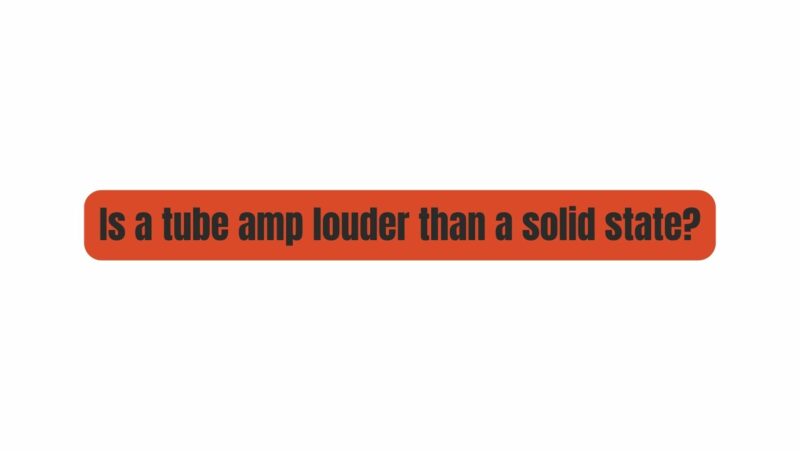In the realm of audio amplification, volume matters. Whether you’re a musician performing on stage, a recording engineer in a studio, or a dedicated audiophile seeking the perfect listening experience, the loudness of your amplifier plays a crucial role. A long-standing debate in the audio world revolves around the perceived differences in volume output between tube amplifiers and solid-state amplifiers. In this article, we will delve deep into the intricacies of both technologies to answer the age-old question: Is a tube amp louder than a solid-state amp?
Understanding Amplification Technologies
Before we explore the question of loudness, it’s essential to understand the fundamental differences between tube and solid-state amplifiers.
- Tube Amplifiers: Tube amplifiers, also known as valve amplifiers, employ vacuum tubes (electron tubes) to amplify audio signals. These tubes are known for their warm, harmonically rich sound, but they also have certain limitations, including relatively low power efficiency and a shorter lifespan compared to solid-state components. Tube amps are renowned for their musicality and natural distortion characteristics, which many musicians and audiophiles find appealing.
- Solid-State Amplifiers: Solid-state amplifiers, on the other hand, utilize semiconductor devices like transistors and integrated circuits for amplification. They are known for their reliability, efficiency, and ability to produce clean, linear amplification. Solid-state amps are often associated with accurate and precise sound reproduction, making them a staple in professional audio setups.
Power Output and Loudness
The loudness of an amplifier primarily depends on its power output, measured in watts (W). Generally, higher wattage amplifiers can produce louder sound, assuming all other factors remain constant. This leads to the common misconception that tube amplifiers are louder than solid-state amplifiers. Let’s explore this notion in detail:
Tube Amps and Loudness:
Tube amplifiers often have lower power ratings compared to solid-state counterparts. Common tube amplifiers may range from 5 watts to 50 watts or more, while solid-state amplifiers can deliver hundreds or even thousands of watts. Due to this disparity in power output, it’s easy to assume that tube amps are quieter.
However, tube amplifiers have a unique characteristic known as “soft clipping” when they reach their maximum power. This means that when pushed to their limits, tube amps produce a gradual and musical distortion, which can be perceived as “louder” by the human ear. This subjective perception of loudness, driven by harmonic distortion, is why some people believe tube amps are louder at lower wattage ratings.
Additionally, tube amplifiers often exhibit a different type of compression, known as “sag,” as they approach their power limits. This dynamic compression can make the perceived loudness of a tube amp different from its solid-state counterpart.
Solid-State Amps and Loudness:
Solid-state amplifiers, with their higher power output capabilities, can deliver more raw volume when compared to tube amplifiers with similar wattage ratings. Their clean and linear amplification provides a straightforward measurement of loudness based on wattage.
Moreover, solid-state amps tend to have a faster transient response, ensuring that the audio signal is reproduced accurately without introducing harmonic distortion. This means that the loudness of a solid-state amp can be more predictable and consistent, making it suitable for applications where precise control over volume is essential.
Factors Influencing Perceived Loudness
It’s important to note that loudness perception is a complex phenomenon influenced by various factors beyond wattage. Here are some additional factors that can impact how we perceive the loudness of an amplifier:
1. Harmonic Distortion: As mentioned earlier, tube amps produce harmonic distortion when pushed to their limits. This distortion can create the perception of increased loudness, even when the measured wattage is lower than that of a solid-state amp.
2. Speaker Efficiency: The efficiency of the speakers used in conjunction with an amplifier can significantly affect perceived loudness. Some speakers are more efficient in converting electrical power into acoustic energy, making them appear louder when paired with any amplifier.
3. Room Acoustics: The acoustic characteristics of the listening environment or performance space can greatly influence how sound is perceived. Room reflections, absorptions, and resonances can either enhance or dampen the perceived loudness of an amplifier.
4. Equalization and Sound Processing: The tonal balance and equalization settings used with an amplifier can alter how loud certain frequencies are perceived. A well-tailored EQ can make specific frequencies stand out, contributing to the perception of loudness.
Conclusion
In the end, the question of whether a tube amp is louder than a solid-state amp is not easily answered with a simple “yes” or “no.” It hinges on various factors, including the amplifier’s wattage, harmonic distortion characteristics, speaker efficiency, room acoustics, and user preferences.
Tube amplifiers, with their harmonic richness and distortion characteristics, can create the subjective sensation of increased loudness even at lower wattages. Solid-state amplifiers, with their higher power output and cleaner amplification, offer a more straightforward and predictable loudness based on wattage.
Ultimately, the choice between tube and solid-state amplifiers should be guided by your specific audio needs and personal preferences. Both technologies have their merits, and the “loudness” factor is just one of many considerations when selecting the right amplifier for your audio setup.


